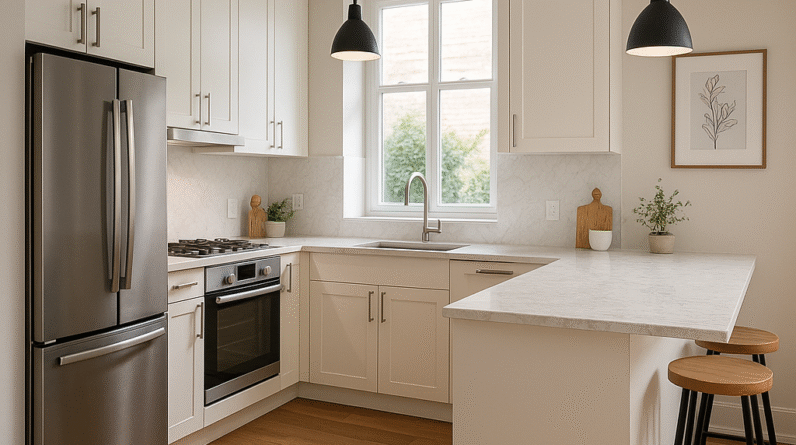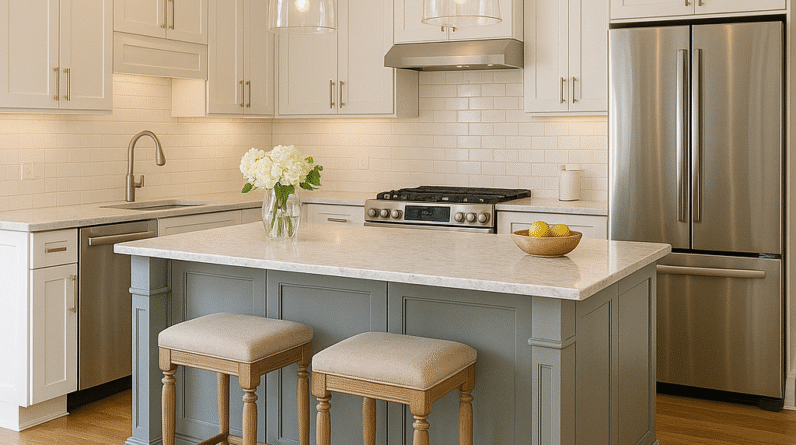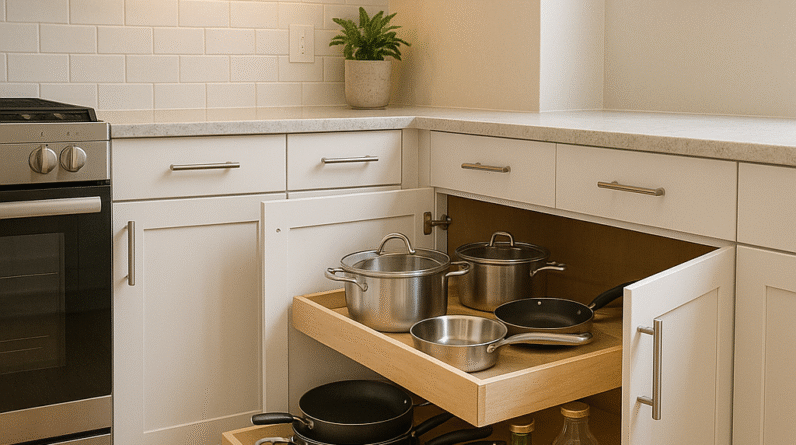
Is $20000 Enough For A Kitchen Remodel?
Is $20000 Enough For A Kitchen Remodel? So you’re considering remodeling your kitchen, but you’re not quite sure if a budget of $20000 will be enough to get the job done. Well, fret not! In this article, we will explore whether or not this amount is sufficient for a kitchen remodel and provide you with insights on how to make the most of your budget. Whether you’re looking to update your appliances, revamp the cabinetry, or give your kitchen a complete makeover, we’ve got you covered. So grab a cup of coffee, sit back, and let’s dig into the details.
Factors to Consider
Size of the Kitchen
The first factor to consider when planning a kitchen remodel is the size of your kitchen. The size of your kitchen will greatly impact the overall cost of the project. Larger kitchens will require more materials and labor, which can increase the cost. It’s important to take accurate measurements and consider the layout of your kitchen when determining the scope of your remodel.
The scope of your kitchen remodel refers to the extent of the changes you plan to make. Are you just updating the cabinets and countertops, or are you completely gutting the kitchen and starting from scratch? The more extensive the remodel, the higher the cost will be. It’s important to clearly define your remodel goals and prioritize the changes you want to make.
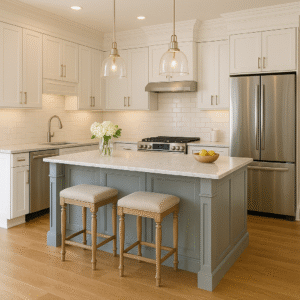
Quality of Materials
The quality of materials you choose for your kitchen remodel will greatly impact the cost. Higher quality materials, such as solid wood cabinets and granite countertops, will be more expensive than lower quality options. It’s important to consider your budget and weigh the cost against the durability and aesthetics of the materials.
Labor Costs
Labor costs are another significant factor to consider when budgeting for a kitchen remodel. Hiring professionals to do the work can be quite expensive, but it ensures that the job is done correctly and efficiently. On the other hand, choosing to do the work yourself can save money on labor costs, but it requires more time and skill. You should carefully consider your own abilities and the complexity of the project before deciding whether to hire professionals or take on the task yourself.
Average Cost Breakdown
Cabinets
Cabinets are one of the most expensive components of a kitchen remodel. High-quality cabinets can cost anywhere from $5,000 to $20,000 depending on the size of your kitchen and the materials you choose. However, there are ways to save on cabinet costs such as refacing instead of replacing them or choosing ready-to-assemble options.
Countertops
Countertops are another significant expense in a kitchen remodel. The cost of countertops depends on the material you choose, with options ranging from laminate to granite. Laminate countertops can be more affordable, starting at around $20 per square foot, while granite countertops can range from $50 to $100 per square foot. It’s important to consider the durability, maintenance, and appearance of different countertop materials when making your selection.
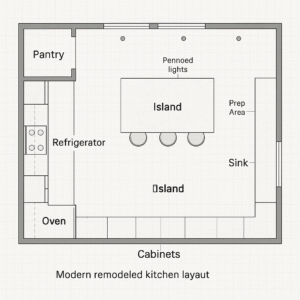
Appliances
Appliances can greatly impact the cost of a kitchen remodel. Upgrading to high-end, energy-efficient appliances can increase the cost significantly. On average, the cost of replacing appliances in a kitchen remodel can range from $5,000 to $10,000. If you’re on a tight budget, opting for mid-range appliances can help to keep costs down while still giving your kitchen an updated look.
Flooring
Flooring can also be a significant expense in a kitchen remodel. The price of flooring varies depending on the material you choose, with options such as vinyl, tile, laminate, and hardwood. Vinyl flooring is often the most affordable, starting at around $2 per square foot, while hardwood flooring can range from $5 to $12 per square foot. It’s important to choose a flooring material that is durable, easy to clean, and matches the overall aesthetic of your kitchen.
Lighting
Lighting is an important aspect of any kitchen remodel and can greatly impact the overall cost. The cost of lighting fixtures, including recessed lights, pendant lights, and under cabinet lighting, can range from $500 to $2,000 or more. It’s important to consider the type and placement of lighting in your kitchen to ensure adequate illumination while creating a welcoming and functional space.
Plumbing changes may be necessary during a kitchen remodel, particularly if you’re changing the layout or adding new fixtures. The cost of plumbing work can vary depending on the complexity of the project, but it’s important to budget for potential expenses such as moving water and gas lines, installing new sinks and faucets, and connecting appliances.
Electrical
Electrical work is another potential cost in a kitchen remodel, especially if you’re adding new lighting fixtures or outlets. Hiring a licensed electrician to handle any electrical changes or upgrades is crucial to ensure the work is done safely and up to code. The cost of electrical work can vary depending on the scope of the project, so it’s important to plan and budget accordingly.
Miscellaneous Expenses
Miscellaneous expenses can easily add up during a kitchen remodel. These can include permits and inspection fees, delivery and installation charges, as well as any unforeseen expenses that may arise. It’s important to budget for these additional costs and set aside a contingency fund to cover any unexpected expenses that may occur.
Cost-Saving Tips
Refacing Cabinets
Instead of replacing your cabinets entirely, consider refacing them to save money. Refacing involves replacing just the cabinet doors and drawer fronts while keeping the existing cabinet frames. This can significantly reduce costs while still giving your kitchen a fresh and updated look.
Opting for more affordable materials can help keep costs down in a kitchen remodel. For example, choosing laminate countertops instead of granite or using vinyl flooring instead of hardwood can save a significant amount of money. While these materials may not have the same luxury appeal, they can still provide durability and functionality at a fraction of the cost.
Opting for Mid-Range Appliances
Rather than splurging on high-end appliances, consider opting for mid-range options. Mid-range appliances can still offer modern features and a stylish appearance without the hefty price tag. This can help you save money while still achieving the desired look and functionality for your kitchen.

Another way to save on costs is by optimizing your lighting fixtures. Instead of installing expensive recessed lighting throughout the entire kitchen, consider using a combination of recessed lights and strategically placed pendant or under cabinet lights. This can help to create an inviting atmosphere while reducing the overall cost of lighting fixtures.
Budget Allocation
Determining Priorities
When working with a limited budget for a kitchen remodel, it’s important to determine your priorities. Ask yourself what elements of your kitchen are most important to you and allocate the majority of your budget towards those. This could include things like updating cabinets or replacing appliances. By focusing on your top priorities, you can ensure that your money is being spent where it will have the most impact.
Allocating Funds for Different Categories
Once you have determined your priorities, it’s important to allocate your funds accordingly. Create a budget breakdown and allocate percentages or specific dollar amounts to each category, such as cabinets, countertops, appliances, flooring, and so on. This will help you stay organized and ensure that you are allocating enough funds to each aspect of your kitchen remodel.
Hiring Professionals
Research and Get Multiple Quotes
If you decide to hire professionals for your kitchen remodel, it’s important to do your research and get multiple quotes. Research different contractors or companies in your area and compare their prices, services, and customer reviews. Getting multiple quotes will give you a better understanding of the average cost and help you find the best fit for your project.
Before hiring any professionals, it’s crucial to verify their credentials. Make sure they are licensed, insured, and have experience in kitchen remodeling. You can also ask for references or photos of previous work to ensure they have a track record of delivering quality results.
Check Reviews and References
Checking reviews and references is another important step when hiring professionals. Look for reviews on websites, social media, or ask for references from the contractors you are considering. Hearing about other people’s experiences can give you valuable insight into the quality of their work and their professionalism.
DIY vs Hiring Professionals
Benefits of DIY
One option for saving money on a kitchen remodel is to tackle the project yourself. DIY can be a cost-effective approach, especially if you have the necessary skills and experience. It allows you to have complete control over the project and can be a rewarding experience.
Drawbacks of DIY
However, there are drawbacks to taking on a kitchen remodel yourself. It requires a significant amount of time, effort, and skill. If you’re not experienced in construction or remodeling projects, you may end up making costly mistakes or taking much longer than anticipated. It’s important to realistically assess your abilities and consider the complexity of the project before deciding to go the DIY route.
Advantages of Hiring Professionals
Hiring professionals for your kitchen remodel has several advantages. They have the necessary skills and experience to ensure that the project is done correctly and efficiently. They can also provide valuable advice and recommendations based on their expertise. Additionally, hiring professionals can save you time and effort, allowing you to focus on other aspects of the remodel or your daily life.
Limitations of Hiring Professionals
The main limitation of hiring professionals is the cost. Labor costs can be a significant portion of the overall budget for a kitchen remodel. It’s important to carefully consider your budget and the value you place on your time and the quality of the finished project when deciding whether to hire professionals or take on the project yourself.
Hidden Costs
Unforeseen Structural Issues
During a kitchen remodel, it’s not uncommon to encounter unforeseen structural issues. This could include water damage, plumbing or electrical issues, or problems with the existing infrastructure. These unexpected issues can significantly impact the cost of the remodel. It’s important to build a contingency fund into your budget to account for any unforeseen expenses that may arise.
Permit and Inspection Fees
Permits and inspection fees are often required for a kitchen remodel, depending on your location and the scope of the project. These fees can vary but should be factored into your budget. It’s important to research the specific requirements and costs in your area to ensure compliance and avoid any potential fines or delays.
Delivery and Installation Charges
When purchasing new appliances or materials for your kitchen remodel, it’s important to account for delivery and installation charges. These charges can vary depending on the size and weight of the items and the distance they need to be transported. It’s important to factor these additional costs into your budget to avoid any surprises.
Decor and Finishing Touches
The cost of decor and finishing touches can also add up during a kitchen remodel. This includes items such as paint, cabinet hardware, backsplash tiles, window treatments, and other decorative elements. It’s important to budget for these items and consider them in your overall cost breakdown.
Alternative Financing Options
Personal Loans
If you don’t have enough saved up for a kitchen remodel, personal loans can be a viable financing option. Personal loans are typically unsecured loans that can be used for various purposes, including home improvement projects. It’s important to compare loan terms, interest rates, and repayment terms to find the best option for your financial situation.
Home Equity Loans
Another financing option for a kitchen remodel is a home equity loan. Home equity loans allow you to borrow against the value of your home. They typically have lower interest rates than personal loans but require you to use your home as collateral. It’s important to understand the terms and risks associated with home equity loans before considering this option.
Credit Cards
Using credit cards for a kitchen remodel can provide a convenient and flexible financing option. However, it’s important to carefully consider the interest rates and repayment terms associated with credit card debt. High-interest rates can quickly add up and make the overall cost of the remodel significantly higher.
Grants and Assistance Programs
There may be grants or assistance programs available in your area that can help offset the cost of a kitchen remodel, particularly if you qualify based on income or other criteria. These programs can provide financial assistance or low-interest loans to homeowners looking to make improvements. It’s worth researching and exploring any potential grants or programs that may be available to you.
Creating a Realistic Budget
Researching Local Costs
When creating a budget for your kitchen remodel, it’s important to research local costs. Prices can vary depending on your location, so it’s important to have a clear understanding of what you can expect to pay for materials and labor in your area. Researching local costs will help you create a more accurate and realistic budget.
Getting Multiple Quotes
Getting multiple quotes from contractors or suppliers is essential for creating a realistic budget. By obtaining several quotes, you can compare prices, services, and materials to ensure you are getting the best value for your money. It’s important to consider factors such as reputation, contract terms, and warranty when evaluating quotes.
Setting a Contingency Fund
Finally, it’s crucial to set aside a contingency fund when creating your budget. As mentioned earlier, unforeseen issues can arise during a kitchen remodel, and having a contingency fund will help cover any additional expenses that may come up. It’s generally recommended to set aside 10-20% of your total budget as a contingency fund.
Conclusion
In conclusion, a $20,000 budget can be enough for a kitchen remodel if you carefully consider and prioritize your expenses. Factors such as the size of the kitchen, scope of the remodel, quality of materials, and labor costs all play a significant role in determining the overall cost. By researching costs, getting multiple quotes, and creating a realistic budget that includes a contingency fund, you can successfully complete a kitchen remodel within your budget. Whether you choose to hire professionals or take on the project yourself, it’s important to balance cost savings with the desired aesthetics and functionality of your new kitchen. With careful planning and budgeting, you can achieve the kitchen of your dreams without breaking the bank.

